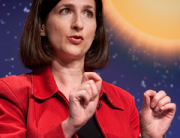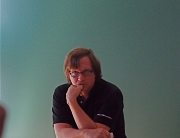After traveling three billion miles, over a period of almost ten years, NASA’s New Horizons spacecraft is on its way to Pluto to perform first ever Pluto flyby. In this podcast Dr Mark Showalter, senior research scientist and principle investigator at the SETI institute, describes in detail the nature of this mission and what to expect in terms of scientific findings. Dr Showalter describes different features of the spacecraft, talks about the instruments on-board, and discusses the challenges involved as the spacecraft approaches Pluto.
Dr Showalter works on some of NASA’s highest profile missions to outer planets. He has been a member of Cassini Mission Science Team for nearly a decade, and is involved in the observations of Jupiter’s rings using New Horizons spacecraft. A frequent user of Hubble Space Telescope, Dr Showalter has to his credit the discovery of Jupiter’s outer most ring, Saturn’s moon PAN, and two moons and two faint rings around the planet Uranus.
Pluto is an interesting and complicated alien world. The Pluto system has four moons that orbit around the central binary system, which consists of Pluto and its large moon Charon; Dr Showalter explains the Pluto system in detail. Dr Showalter discusses the duration of the flyby and how close the spacecraft will come to Pluto and its moons; he then touches upon the following points:
- What are main observations that the scientists intend to make and what are main expectations that the scientists have in their minds as the New Horizon spacecraft is about to flyby Pluto.
- The New Horizons spacecraft has the capability to fly beyond the Pluto system. After the Pluto flyby, what is next for the New Horizons spacecraft? Where will the spacecraft go from there?
- Whatever direction the spacecraft takes after the Pluto flyby, for how long will the spacecraft be able to communicate? How much fuel the spacecraft has and how long will it stay in the communication range? Will this spacecraft follow the footsteps of Voyager-1 and Voyager-2 and will continue travelling beyond the solar system?
As the spacecraft approaches Pluto, Dr Showalter and his colleagues are getting ready to manage a number of crucial aspects of this mission. Dr Showalter discusses his role in this mission. An interesting question that arises at this point is that, as the spacecraft approaches Pluto, if an anomaly is spotted, would the team have enough time to send a command to the spacecraft from such long distance, and would there be enough time to get any such command executed on time to deal with any anomaly.
Dr Showalter talks about the “Our Pluto Campaign” launched by SETI: SETI has invited public to help name features on Pluto. I finish this podcast by asking Dr Showalter about upcoming space missions that are being planned, and about new developments in his area of research.






Connect With Us